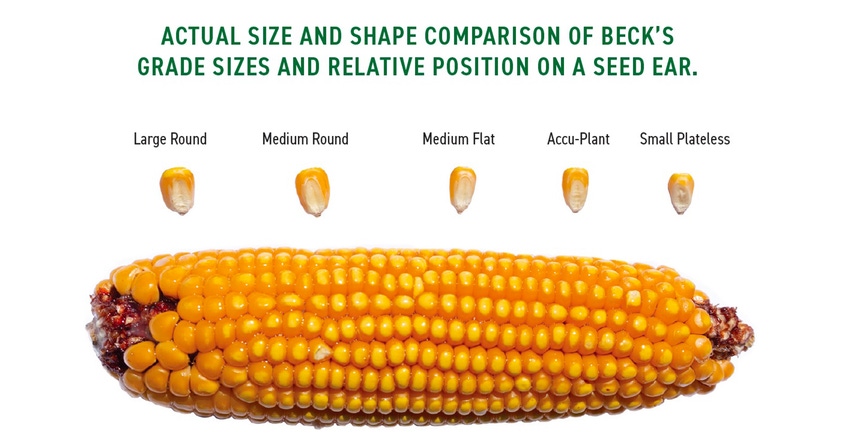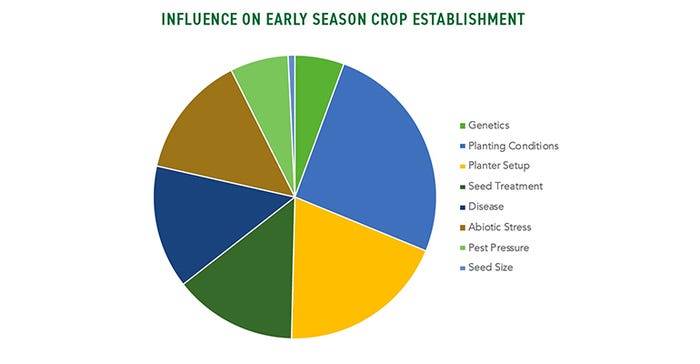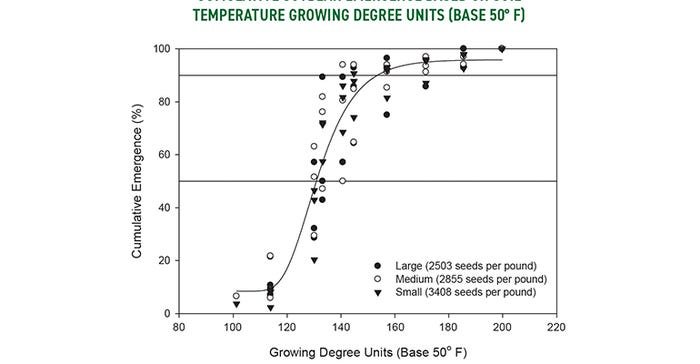January 1, 2022

Sponsored Content
For a crop to become established, the seeds must germinate and emerge uniformly. Seed size and shape (also called grade size) is not correlated to germination, vigor, nor yield. If planting conditions are good, all grades have equal quality and the size and health of the embryo within the seed does not change with grade size.
GRADE SIZE is determined by genetics and the relative position of the kernel on the seed ear. All kernels on the same seed ear have the same genetic yield potential. Pollination typically begins at the base of the ear and the resulting kernels are larger. When seed ears don’t completely pollinate, the fewer kernels result in an overall larger kernel size on that seed ear. Smaller grade sizes come from the tip of the ear. Market grade size is determined by the three-dimensional shape of the kernel, together with seed weight and other factors. Kernels within one grade size are sufficiently similar to ensure consistent plantability.
GERMINATION is the physiological process of the seed imbibing water, reconstituting dehydrated cells, and initiating growth. Germination ends with the plant developing root and shoot tissue and breaking through the soil surface. Warm germination testing is required by law, and the results are published on the seed tag.
EMERGENCE is the plant breaking through the soil surface. Some seeds may germinate but fail to emerge due to poor soil conditions, disease or insect feeding. Hybrid-specific emergence ratings published by Beck’s are the result of comparing one hybrid relative to others in the same environment.
VIGOR is a somewhat subjective term that typically pertains to the speed and uniformity at which the seed germinates and emerges.
Uniform germination is a product of good seed-to-soil contact, consistent soil temperature, and even soil moisture. Corn seeds must imbibe 30% of the seed’s weight in water to initiate germination; for soybeans, it’s 50%. This is a function of seed weight, so under very dry conditions it can be a slight advantage to smaller seeds, which require less water to germinate.

The period between germination and emergence is a vulnerable time for the crop. Corn requires 100 to 120 Growing Degree Days (GDDs) to emerge; soybeans require upwards of 130 GDDs. In that time, plants rely on energy from the seed to push leaves up and establish the root system. If there is an extended cool, wet period between germination and emergence, a larger seed has greater energy reserves. Planting into warm soil, at least 50°F, is more important than seed size in determining uniform emergence.
A comprehensive seed treatment package ensures the health of the young plant. Beck’s Escalate® powered by Nemasect™ seed treatment provides protection from a wide range of soil-borne pathogens and includes helpful biologicals and growth promoters that help the young plant get off to a good start.
The graph below demonstrates the GDDs required for soybeans to emerge across multiple seed sizes. Corn behaves similarly with respect to seed size and GDDs to germination.

Management Considerations:
Seed size (seeds/lb.) and minimum germination percentage are found on the seed tag. All Beck’s seed meets stringent quality parameters.
Kernel grade size does not impact silking date or grain yield.
Wait until soils are at least 50°F to plant. Cold soils can cause plants to leaf out underground.
Adjust your planter for each grade size. Be sure to follow the manufacturer’s recommendations and readjust if switching from one grade size to another.
The fitness of your soil is as critical as the planting operation for seed-to-soil contact and minimizing emergence difficulties from open seed slots or crusting.
FOR ADDITIONAL INFORMATION:
https://www.beckshybrids.com/Products/Seed-Treatments
crops.extension.iastate.edu/corn/production/management/planting/kernel.html
https://www.agry.purdue.edu/ext/corn/news/articles.96/p&c9606.htm
http://www.coolbean.info/pdf/soybean_research/early_season/Predicting_soy_emergence.pdf
Beck's - Farmers At Heart® - revolutionized the customer seed buying experience by remaining true to a foundation built on faith, family, and farming. Founded in 1937, Beck's appreciates the farmers who have helped them become the largest family-owned retail seed company and the third largest seed brand in the United States. The Beck family is now in its fifth generation of family members who work in the business to honor God and help farmers succeed. The Beck family and team of employees help farmers achieve success from generation to generation through authentic customer experiences, product diversity, seed quality, and performance. With a home office located in Atlanta, Ind., Beck's serves farmers throughout the Midwest and Mid-South. For more information about Beck's Superior Hybrids, Inc., visit www.beckshybrids.com.
About the Author(s)
You May Also Like




